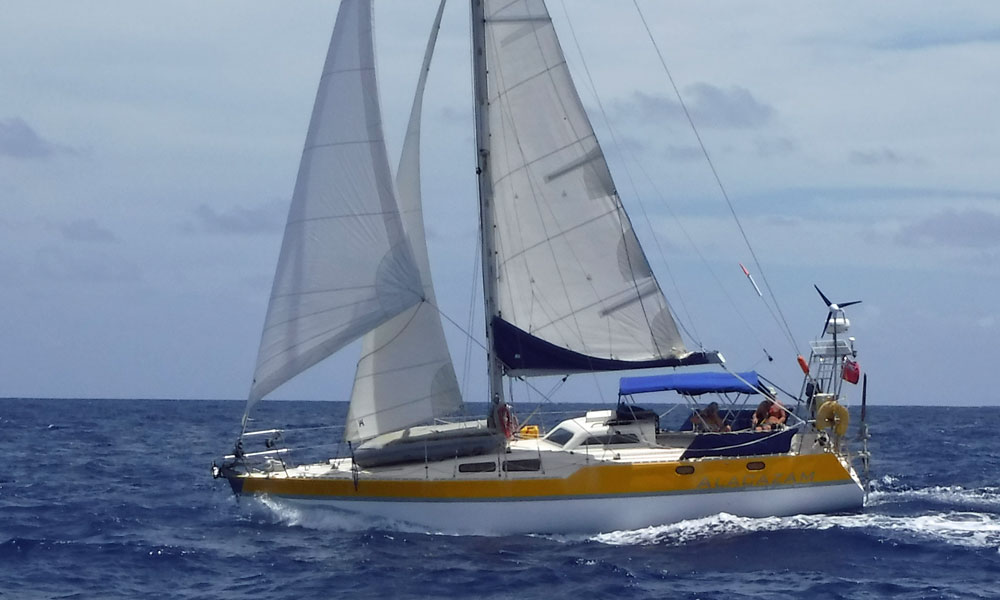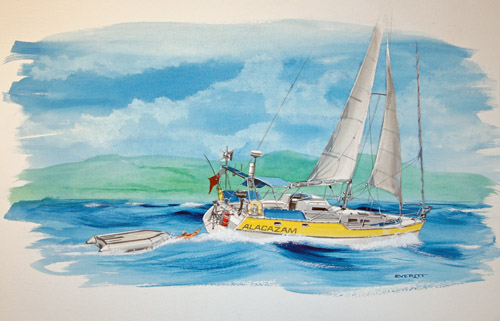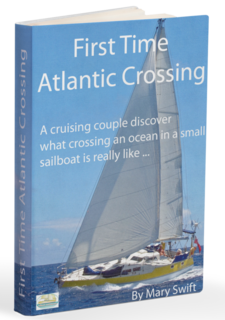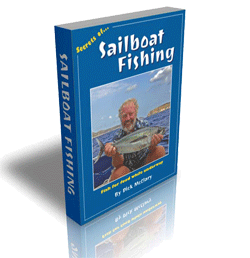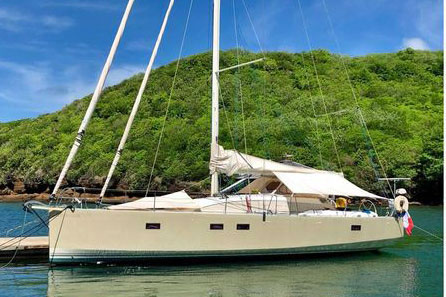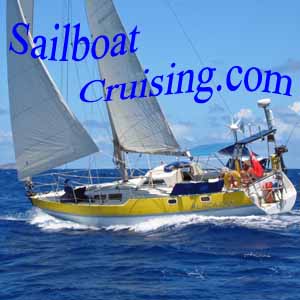- Home
- Sailing in the Caribbean
Getting Ready for Caribbean Sailing
Information for Skippers & Crew
On this page...
- The Caribbean Sailing Season;
- Sea & Weather Conditions;
- Navigation;
- Customs & Immigration Formalities;
- Anchorages & Moorings;
- Yacht Services & Facilities;
- Local Currencies;
- Vaccinations Required;
- Travel Insurance & Medicare;
- Buying a Used Sailboat in the Caribbean;
- Chartering in the Eastern Caribbean;
- Catch a Fish with a Simple Handline;
For most of us, the very words 'Caribbean sailing' conjure up a very agreeable mental image - blue skies, fluffy white clouds, constant warm trade winds, idyllic anchorages and 12 hours of sunshine every day.
It's not always like that of course; occasional squalls can provide rather more wind and rain than you'd vote for, and some of the flying insects seem set on doing little to improve your day.
All in all though, Caribbean sailing is the stuff of dreams...
For most of us fortunate enough to sail these waters, the real jewels in the Caribbean crown are those islands to the east of Puerto Rico - the Eastern Caribbean - and it's to this part of the Caribbean that most cruisers lay their course for.
These comprise the Virgin Islands (BVIs and USVIs) and those island nations that make up the Windward Islands and Leeward Islands.
You'll find yourself needing a number of Courtesy Ensigns for a Caribbean sailing season, and it's as well to get them before you set off.
The Caribbean Sailing Season
The season kicks-off in December and fizzles out in June but, were it not for hurricanes, would be year-round.
These ferocious meteorological events - even with the availability of increasingly reliable forecasts and track predictions - make sailing in the hurricane season an extremely risky affair.
Some intrepid cruisers choose to take advantage of the balmy summer weather and empty anchorages, while keeping a very keen eye on any hurricane as it tracks across the Atlantic Ocean. They reckon they have at least three days to find a suitable hurricane hole. Even so...
By this time the rest of us have found a suitable boatyard to lay-up our boats and scuttled back to the safety of our homes elsewhere.
Sea & Weather Conditions
Prevailing Winds
The Eastern Caribbean Islands lie in the path of the North East Trade Winds, but these swing through to the southeast quadrant from time to time. As a general rule they're stronger and more north-easterly in the winter, and veer south-easterly in the summer.
Typically they blow at 10 to 25 knots, but often in January/December they can blow up to 30 knots when they're known as 'Christmas winds'.
Squalls
These announce the impending arrival with an ominous-looking black cloud on the horizon.
Treat them initially as you would a huge oil tanker. It's not going to stop and probably won't change direction. Will it pass ahead or astern? Can I avoid it by changing my course, ideally passing astern of it?
If a squall is heading your way and you can't avoid it, take appropriate action for a lot of wind - sometimes 40 knots or so - and intense rain with loss of visibility. Prepare to reduce sail, sheet in and take it on the chin. The odds are it won't be as bad as you were expecting and it'll probably be all over in a few minutes - but still, you need to be ready before it hits.
Sea Conditions
In the lee of the islands, as you might expect, the sea is fairly flat. On passage between the islands you'll experience the long, ocean swells that have swept across several thousand miles of the Atlantic which - combined with the constant, warm tradewinds - makes for wonderful sailing.
But be prepared for the wind acceleration zones that often occur at the ends of the islands. The wind strength may well increase by at least 10 knots in seconds, kicking up steep short seas.
Some locations are notorious for this effect - the Northern end of St Vincent is a prime example.
During the winter months, storms well to the north of the islands can produce heavy northerly swells that can make otherwise calm anchorages uncomfortable at best, or completely untenable.
Navigation
First though, you have to get there - as this ebook describes...
Tides & Currents
Sailing between the islands, you can normally see the next one before losing sight of the one you've left but be aware that your course over the ground will be offset to the west by the Equatorial Current.
This flows in a north-westerly direction, varying from next to nothing up to a knot or so - sometimes more around the ends of the islands.
Take a back-bearing on the island astern to estimate the effect of the current - or more likely, just take a look at your chartplotter and compare your course line with the rhumbline.
Although the tidal range is only around 11/2 feet (0.5m), tidal currents do have an effect - you'll see where and what this is on your charts.
Buoyage
The IALA 'B' (Red-Right-Returning) Buoyage system is in use throughout the Caribbean. Those of you who hail from the US will be familiar with this, but for Europeans (where IALA 'A' (Red-Port-Left-In) is used, this will be confusing at first.
Not that you'll see much buoyage, other than for marking big-ship channels. Neither are they very reliable - they get moved (or entirely removed) by hurricanes and it can take time to get them replaced.
What you will see plenty of are of are fishing pot buoys. Now I'm going to contradict myself by saying that you often won't see them, as they often made of clear plastic bottles or are being dragged below the surface by the current. I know the fisherman have got to make a living, but if they made their gear more visible they'd lose a lot less of it - and avoid the wrath of we yachties.
Charts & Pilots
I'm a firm believer in having paper charts even if you've got a chart plotter. The ones I use for the Caribbean sailing are published by NV Charts.
Along with every other cruiser I've met in the Windward and Leeward Islands of the Caribbean, I rely on the cruising guides written by Chris Doyle.
They're updated every two years, and in my view are absolutely indispensable for Caribbean sailing.
But not just for sailing. Not only has Chris got thousands of miles of Caribbean sailing under his keel (or maybe daggerboards - Chris sails a catamaran) but he's tramped all over the islands on foot too.
Consequently, the island trails and shoreside delights are covered in detail too. Quite rightly in my opinion, the 'Chris Doyle Cruising Guides to the Windward & Leeward Islands' are the most popular of all.
Customs & Immigration Formalities
The Eastern Caribbean is made up of a number of Nation States. Some are individual Islands - St Lucia for example - or a group of islands such as St Vincent & the Grenadines.
Their entry procedures are different, although they all involve a trip to Customs and Immigration (and sometimes the Police). Always turn up with the passports of all your crew, plus the boat papers. Once you know the system it's all fairly straightforward, but it can be a little tedious in some places.
Always be polite, courteous, and patient - especially patient if they've got the cricket on TV and the West Indies is batting! You won't be welcome if you're dressed scruffily; as a minimum it's sandals, a presentable T-shirt and your best shorts.
Generally the French Islands (St Martin, St Barts, Guadeloupe and Martinique) are the most efficient, but other countries are catching up using an online processes such as eseaclear.com or sailclear.com.
More about yacht clearance and entrance formalities...
Anchorages & Moorings
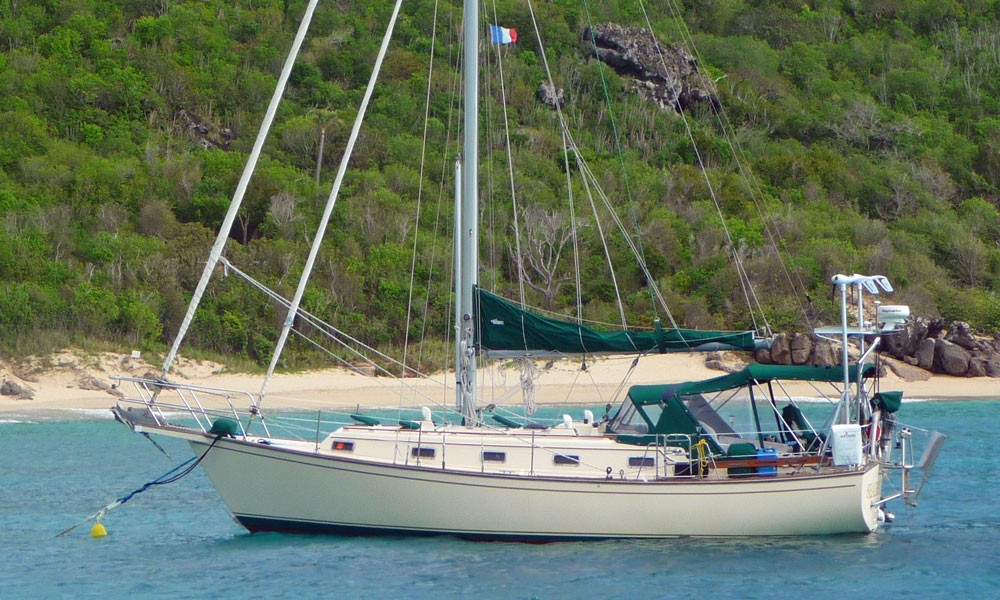 But just how secure is that mooring?
But just how secure is that mooring?Idyllic anchorages abound throughout these islands - just take a look at the Chris Doyles Guides mentioned previously and you'll see what I mean. Most are on the west side of the islands in the lee of the prevailing trade winds.
For more adventurous types, exquisite anchorages can be found on the eastern side of the islands in the lee of reefs but open to the wind. Solitude, seldom available on the west side, can be found in these.
Moorings are becoming increasingly available. Too much so in my opinion, because:
- They are there to make money for their owners, not to fill the need of cruisers;
- Generally, they're not maintained. The attitude to routine maintenance is usually 'if it ain't broke don't fix it'. And when it does break, as it inevitably will, it's often 'fixed' to the condition it was in just before it broke.
As may now be apparent, I'm not a fan of local moorings and will avoid them if I can - I have much more faith in my own ground tackle.
If you're on a mooring and it breaks, you're instantly adrift. If you're at anchor and it drags, things happen in relatively slow motion. There, rant over!
Yacht Services & Facilities
You can get pretty much anything done in the Eastern Caribbean providing you know where to go and how to contact.
- Boatyards & Marinas;
- Chandleries & Fishing Gear;
- Diesel Mechanics;
- Dinghy Repair & Liferaft Services;
- Dive Centres & Services;
- Electrical & Electronic Services;
- Gas Bottle Refills;
- Hull Painting and Brightwork Specialists;
- Hull Repair & Gelcoat Specialists;
- Laundries for Cruisers;
- Outboard Motor Servicing & Repairs;
- Refrigeration and Air Conditioning Engineers;
- Rigging Services;
- Sailmakers, Canvaswork & Upholstery;
- Shipwrights & Carpenters;
- Watermaker Services;
- Welding & Stainless Steel Fabrication;
- Yacht Management & Guardianage;
- Yacht Surveyors;
For a full list and contact details of the above service providers is listed at:
Boatyards, Marinas & Yacht Service Providers in the Eastern Caribbean...
Local Currencies
Just three currencies - US Dollars, Euros and Eastern Caribbean Dollar:
- Throughout the Virgin Islands (both US and British) the local currency is the American Dollar ($US);
- For all the others, it's the Eastern Caribbean Dollar ($EC). The exchange rate is fixed at $US1 = $EC2.70;
Vaccinations
So just what vaccinations do you need for Caribbean sailing?
I asked my GP that question and this is what he recommended:
- tetanus;
- polio;
- hepatitis A;
- hepatitis B;
- typhoid;
Apparently, this will provide adequate protection wherever you go in the Eastern Caribbean, but for a more focused and up-to-date recommendation you could take a look at www.masta-travel-health.com/VaccineChecker.
Travel Insurance & Medicare for Caribbean Sailing
However fit and healthy you are, things can go wrong very quickly. A serious illness or injury could mean that you need to get medivac'ed out to the US for urgent medical treatment. Without insurance, this could blow away your entire cruising fund in the first day or two of treatment.
But good insurance doesn't come cheap, so it's absolutely vital to check the terms and conditions in great detail, and ask your prospective insurer as many 'what if...' questions you can think of.
In my experience, insurance offered by companies that are not used to catering for cruising sailors won't meet your requirements. For example, I was offered what appeared to be a very attractive policy by my bank. On checking, it proved to be useless. If I strayed outside territorial waters into international waters, the whole policy became immediately invalid!
Read more about travel insurance for cruising sailors...
Buying a Used Sailboat in the Caribbean
If you're not greatly enthused by the long ocean passage required to get to the Caribbean, there's one very good option available to you - buy a boat already there!
The logistics of doing so can be a little complicated, and the travel costs need to be carefully considered - but you might just pick up a bargain.
Read more, and see what's currently available...
Chartering in the Eastern Caribbean
Unless you:
- Are a long-term cruiser that stays awhile before setting off for another cruising destination or to continue a circumnavigation;
- Are taking a year out to for an Atlantic Circuit before returning home to continue your careers;
- Are a 'snowbird', who keeps your boats in the Caribbean and fly out to it each year, exchanging the unpleasantness of winters in your own country for one of warm, sun-drenched, tropical hedonism. And yes, you're reading the words of one such snowbird right now!
- Are a liveaboard, whose boat is your home and stay aboard year round.
And want to experience the sheer delight of Caribbean Sailing, then chartering a boat is the way to go.
Catch a Fish with a Simple Handline
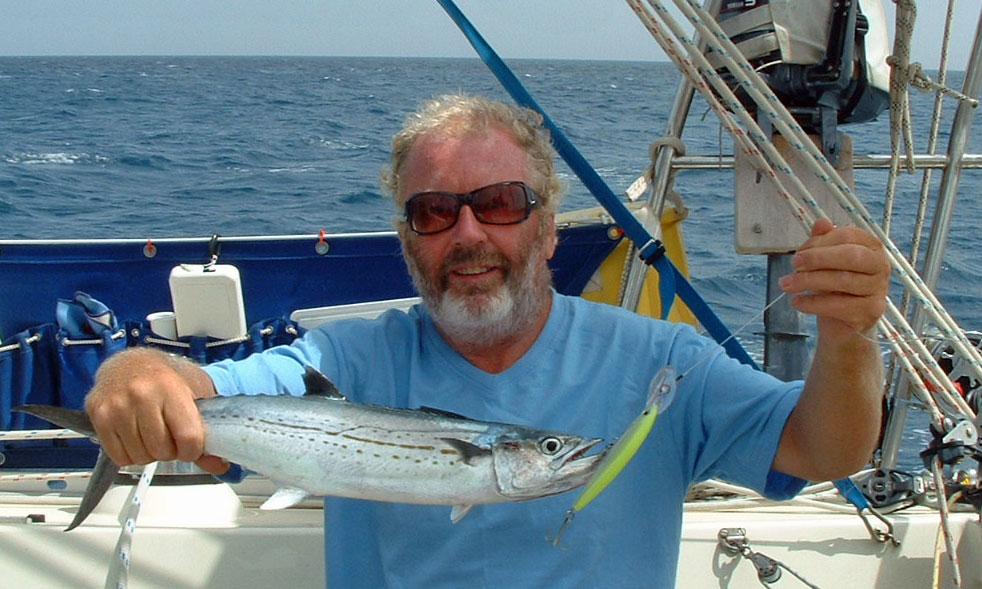 A Spanish Mackerel, straight from the Caribbean Sea
A Spanish Mackerel, straight from the Caribbean SeaThe waters of the Eastern Caribbean abound with fish - and catching them while you're sailing isn't too difficult.
I'm something of a fishing fanatic, and we dine well aboard Alacazam on the produce of our trolling line.
You can expect to catch tuna, wahoo, dorado (Mahe-mahe), Kingfish and Spanish Mackerel - all of which make excellent eating.
But you don't need expensive gear - the fish won't object any more strongly about being caught on a simple handline rather than an expensive rod and reel set-up.
But if you think you might need a little help, download my ebook...
Recent Articles
-
Which Type of Boat Fridge Is The Most Efficient?
Apr 24, 25 05:06 AM
The top opening boat fridge is reputed to be more efficient than the front opening type, but that may not be the case - and here, amongst other boat refrigeration considerations, is why -
Multihull Autopilot Selection is Not Straightforward
Apr 19, 25 01:25 PM
Whether its for a catamaran or a trimaran, tiller or wheel steered, a multi hull autopilot must be endowed with specific performance characteristics... -
Wheel-Steering Autopilots: Your Questions Answered...
Apr 18, 25 03:45 PM
Whatever your question, you should find the answer here
